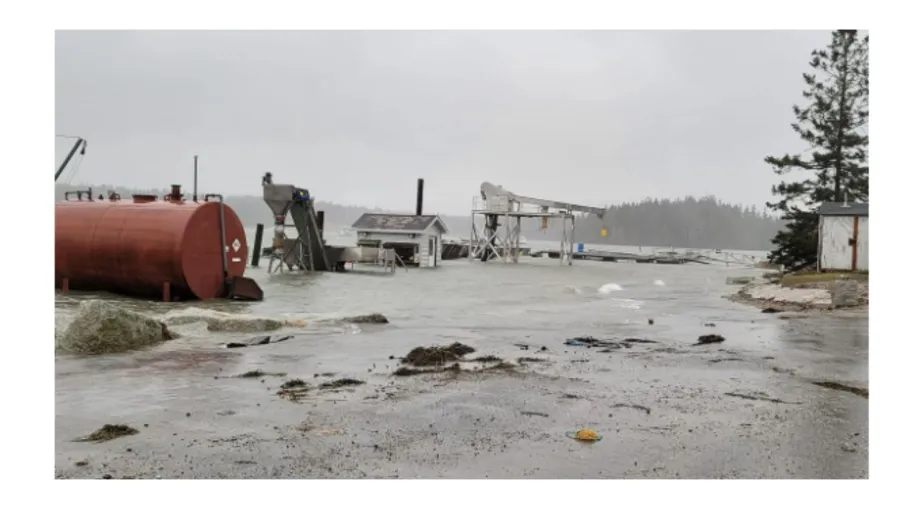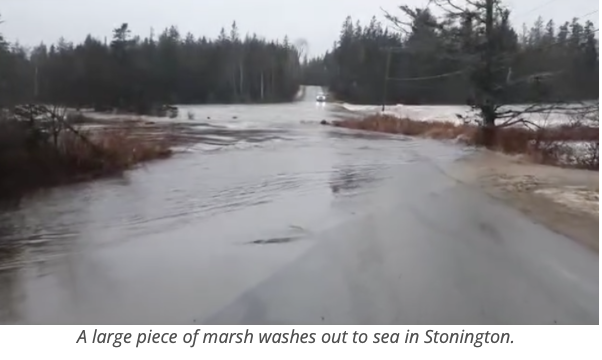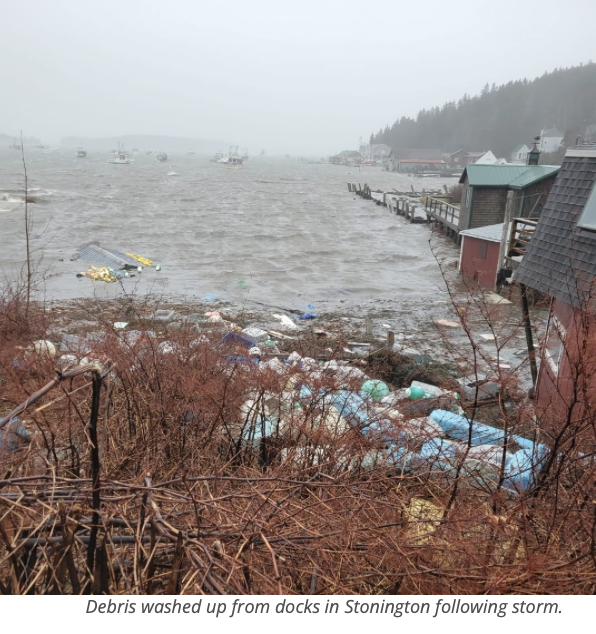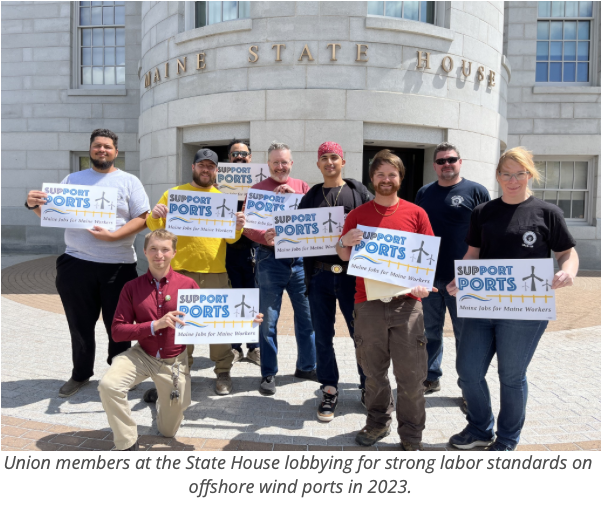Severe Storms Have Wreaked Havoc on Working Class Mainers this Winter

PHOTO: Coastal flooding from January storm in Stonington. PHOTO: Virginia Olsen.
In recent months, a series of severe storms have wreaked havoc on working class communities in Maine, from flooding mill towns and knocking out power to hundreds of thousands of Mainers, to battering fishing villages and laying waste to our working waterfronts. It’s estimated that the combined destruction of the deadly Dec. 18 storm and the Jan. 10 and 13 storms have caused tens of millions in damage in ten Maine counties.
Scientists have linked the increased frequency of severe weather events to the changing of the earth's climate. As global temperatures rise due to heat trapping greenhouse gases in the atmosphere, this affects the water cycle, shifts weather patterns and melts land ice, causing extreme weather like storms, hurricanes and drenching rains to increase in frequency, according to the Intergovernmental Panel on Climate Change (IPCC). It's likely we'll see many more natural disasters like the three record-breaking storms in recent months. In 2023, the number of weather and climate disasters surpassed the previous record set in 2020, coming with a price tag of $92.9 billion.
"Looked like a bomb had gone off"
The January storms were especially damaging to key fishing infrastructure critical to the state’s $1.5 billion lobster industry. Nearly 1,200 businesses submitted damage reportsfrom the January storms to the Maine Emergency Management Agency (MEMA), according to the Portland Press Herald. The Maine Coast Fishermen’s Association told news outlets that its preliminary reporting suggests 60 percent of Maine’s working waterfront was either severely damaged or destroyed.
Up and down the coast lobstering businesses flooded, docks were ripped apart and buildings crumbled into the sea. In Stonington, the state's most valuable lobster fishing port, officials estimate that the January storms caused between $10 million and $15 million dollars worth of damage.
“The extent of damage is just staggering. It literally looked like a bomb had gone off,” Department of Marine Resources Commissioner Patrick Keliher told the Press Herald. “Everything that you could picture being on a dock or associated with a working waterfront – all of that was in the water.”
Maine Lobstering Union (IAM 207) organizer Ginny Olsen lives in Stonington and saw the destruction firsthand. She said that while the tide gets highest once a month during the moon cycle, it generally doesn’t flood. But the combination of the high tide and storm surge proved to be devastating for the little fishing village as it destroyed fishing docks and buildings and flooded electrical infrastructure like fuel pumps and generators. She noted that over 70 percent of the town’s revenue comes from fishing.
 “
“
If we have a bad year, they don’t have the excise tax on snowmobiles and side-by-sides and campers. They lose all that,” she said. “We’re just really concerned about what this year will bring if our infrastructure has more loans they have to pay, no credit line to buy lobster, we would have a depressed price and that leads to a bad year.”
Olsen said many of the docks destroyed in the storm are privately owned by companies, cooperatives and individual fisherman, most of whom do not have insurance to cover flooding. She said even dock owners who had flood insurance were denied claims because it didn’t cover “acts of God.” MEMA has initiated the process to have the impacted communities declared as a federal disaster area. If that happens fishing businesses can qualify for low or no-interest loans to rebuild with the stipulation that they must purchase flood insurance at between $14,000 and $18,000 a year.
While MEMA funds can’t be used to help storm damaged infrastructure owned by co-ops and private entities, there is some potential state funding coming for disaster relief. Governor Janet Mills has proposed investing $50 million from the state’s rainy day fund into the Maine Infrastructure Adaptation Fund to help storm ravaged communities rebuild and ensure their infrastructure can withstand the future impacts of extreme storms.

On Tuesday, MLU testified in support of a measure (LD 2191) sponsored by Sen. Craig Hickman (D-Kennebec) that would establish a $50 million fund to provide relief payments to small businesses affected by severe weather events. However, even when they get the funds, the challenge will be to get the contractors to complete them in time for spring.
“Before the storm they were about 18 months out, so I think it's going be a task just getting someone to do the work you need done,” she said. “We talked to folks about trying to prioritize the commercial waterfront and leave your home personal structures as secondary because we just generate a lot of Maine’s revenue through fishing and aquaculture and if we don’t have working waterfronts that’s going to hurt us.”
Waterfront businesses like fishing businesses and aquaculture companies are pooling their resources to purchase materials like pilings and bring them from the West Coast. The Maine Coast Fishermen’s Association has set up a donation page to support fishermen and working waterfronts in response to the January storms.
Other Storm Ravaged Communities
Other parts of Maine are still recovering from the December 18 storm that killed four people - two while cleaning up storm debris and two who were washed down the river in a 100-year flood near Rumford. The flooding caused about $3 million in damage to a downtown Skowhegan revitalization project while severely damaging the roof over paper machines at the Sappi Mill and causing bridge closures that left many mill workers stranded.
“We had individuals who couldn’t make it to work, but the company was really good about excusing those individuals because they physically could not get to the mill,” said Justin Shaw, President of USW 9.
President Biden has since approved a major disaster declaration for the December storm, making Maine eligible for disaster relief.
During one of the January storms, the Portland waterfront also got hit hard by a record 14.57 foot tide that flooded roads and wharves. Jack Humeniuk, Vice President of International Longshoreman's Association Local 861, said that while the International Marine Terminal where ILA members work loading and unloading container ships was unharmed by the storm, the central waterfront, the Portland Ocean Terminal and Commercial Street were hit hard by flooding.
“Let’s face it, if things appreciably rise the whole waterfront won’t be accessible,” he said. “Imagine another two foot rise in the water levels, so that 14 to 15 foot tides are the norm, that would be kind of scary. What we’re seeing right now is kind of a warning that this is probably not going to change and it’s probably going to get worse so you should probably start thinking about what to do about it.”
Meanwhile, as the Gulf of Maine’s temperature warms faster than 99 percent of the world’s oceans, it is predicted we will see at least another 1.5 more feet of ocean rise by 2050 and four more feet by 2100, according to the Maine Labor Climate Council.
UnionsCanBuild a Climate Resilient Economy

Although climate change is a global problem, there is a major opportunity for Maine’s unionized workforce to be part of the solution. The increasing frequency of severe storms and other extreme weather events affects us all. Private industry and governments around the world are already making massive investments in clean energy and other solutions to address the climate crisis and it’s critical workers have a say in how these projects are deployed and the kind of jobs they support.
Currently, the Maine Labor Climate Council, a coalition of Maine unions, are working on several initiatives to ensure these projects uphold workers’ rights and support union jobs with good wages and benefits
“It’s up to us in the labor movement to lead and push to make sure that those solutions are good solutions,” said Francis Eanes, Executive Director of the Maine Labor Climate Council. “It’s an opportunity to grow the labor movement, but it’s also a vacuum that we leave unfilled if we decide not to participate.”
We may not all be on the same page politically, but if we do this the right way, the rewards for workers and their communities will be tremendous.
“We’ve seen 50 years of deindustrialization and jobs shipped out of Maine,” said Eanes. “This is the opportunity to re-shore those jobs, building out those industries and growing the tax base of our rural and disinvested communities for literally decades to come.”
